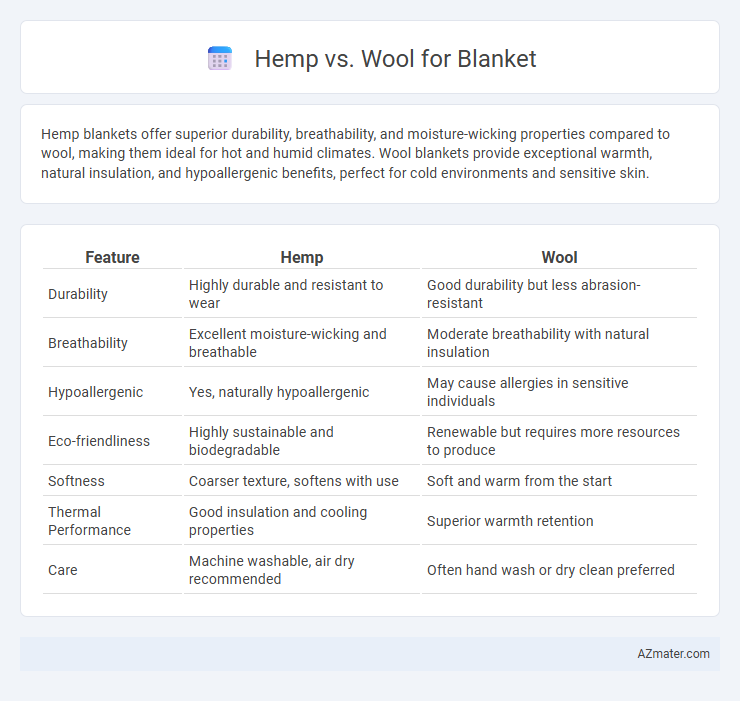Hemp blankets offer superior durability, breathability, and moisture-wicking properties compared to wool, making them ideal for hot and humid climates. Wool blankets provide exceptional warmth, natural insulation, and hypoallergenic benefits, perfect for cold environments and sensitive skin.
Table of Comparison
| Feature | Hemp | Wool |
|---|---|---|
| Durability | Highly durable and resistant to wear | Good durability but less abrasion-resistant |
| Breathability | Excellent moisture-wicking and breathable | Moderate breathability with natural insulation |
| Hypoallergenic | Yes, naturally hypoallergenic | May cause allergies in sensitive individuals |
| Eco-friendliness | Highly sustainable and biodegradable | Renewable but requires more resources to produce |
| Softness | Coarser texture, softens with use | Soft and warm from the start |
| Thermal Performance | Good insulation and cooling properties | Superior warmth retention |
| Care | Machine washable, air dry recommended | Often hand wash or dry clean preferred |
Introduction to Hemp and Wool Blankets
Hemp blankets are crafted from durable, naturally antimicrobial fibers derived from the hemp plant, offering exceptional breathability and moisture-wicking properties. Wool blankets, sourced from sheep fleece, provide superior insulation, warmth, and moisture regulation due to lanolin content and crimped fiber structure. Both options present sustainable, eco-friendly materials with distinct textural and thermal benefits suited for varied climates and preferences.
Material Origins: Hemp vs Wool
Hemp blankets derive from the stalks of the Cannabis sativa plant, providing a sustainable and durable natural fiber with inherent resistance to mold and UV rays. Wool blankets originate from the fleece of sheep, offering excellent insulation and moisture-wicking properties due to the natural lanolin content. Hemp fibers produce a coarse texture ideal for longevity, while wool fibers are softer and ideal for warmth and elasticity.
Sustainability and Environmental Impact
Hemp blankets offer superior sustainability due to their rapid growth, requiring minimal water and pesticides compared to traditional wool production. Wool blankets, while biodegradable, often involve intensive land use and methane emissions from sheep farming, contributing to environmental concerns. Choosing hemp reduces carbon footprint and resource consumption, making it an eco-friendly alternative in blanket materials.
Comfort and Texture Comparison
Hemp blankets offer a naturally coarse texture that softens with use, providing a breathable and moisture-wicking comfort ideal for warm climates. Wool blankets deliver superior warmth with a plush, dense fiber structure that feels soft against the skin, promoting insulation even in cold conditions. The choice between hemp and wool blankets hinges on desired temperature regulation and tactile preference, as hemp excels in durability and eco-friendliness, while wool excels in softness and thermal insulation.
Durability and Longevity
Hemp blankets offer superior durability due to their strong, resistant fibers that withstand wear and tear better than wool. Hemp's resistance to stretching, fading, and pilling contributes to a longer lifespan under frequent use. Wool blankets, while warm and resilient, tend to pill and degrade faster when exposed to moisture and friction over time.
Warmth and Insulation Properties
Hemp blankets provide excellent insulation with their natural breathability and moisture-wicking properties, making them effective in regulating body temperature. Wool is renowned for superior warmth due to its dense fiber structure that traps heat and offers exceptional insulation even when damp. Both materials contribute to thermal comfort, but wool generally outperforms hemp in retaining heat in colder conditions.
Allergy and Skin Sensitivity Factors
Hemp blankets are naturally hypoallergenic and resistant to dust mites, making them ideal for individuals with sensitive skin or allergies. Wool blankets, while warm and breathable, may cause irritation or allergic reactions in people sensitive to lanolin, a natural oil found in wool fibers. Choosing hemp over wool can reduce allergy risks and provide a softer, more skin-friendly texture for those prone to skin sensitivities.
Maintenance and Care Requirements
Hemp blankets require minimal maintenance due to their natural resistance to mold, mildew, and pests, and they become softer with each wash, typically using cold water and gentle detergents. Wool blankets need more careful handling, including dry cleaning or hand washing with specialized wool detergents, and require proper drying flat to maintain shape and prevent shrinkage. Both materials benefit from regular airing and avoiding prolonged exposure to direct sunlight to preserve longevity and texture.
Cost and Accessibility
Hemp blankets generally offer a cost-effective alternative to wool due to lower cultivation and processing expenses, making them more accessible for budget-conscious consumers. Wool blankets, although often higher in price, provide a traditional warmth and durability valued in colder climates, but their cost can be prohibitive for some buyers. Availability of hemp blankets is increasing as sustainable textile demand grows, while wool remains widely accessible through established supply chains in regions with sheep farming.
Choosing the Best Blanket: Hemp or Wool?
Hemp blankets offer superior durability, natural antimicrobial properties, and breathability, making them ideal for allergy sufferers and eco-conscious consumers. Wool blankets provide excellent insulation, moisture-wicking capabilities, and temperature regulation, perfect for cold climates and those seeking warmth. Choosing between hemp and wool blankets depends on individual needs for sustainability, climate, and comfort preferences.

Infographic: Hemp vs Wool for Blanket
 azmater.com
azmater.com